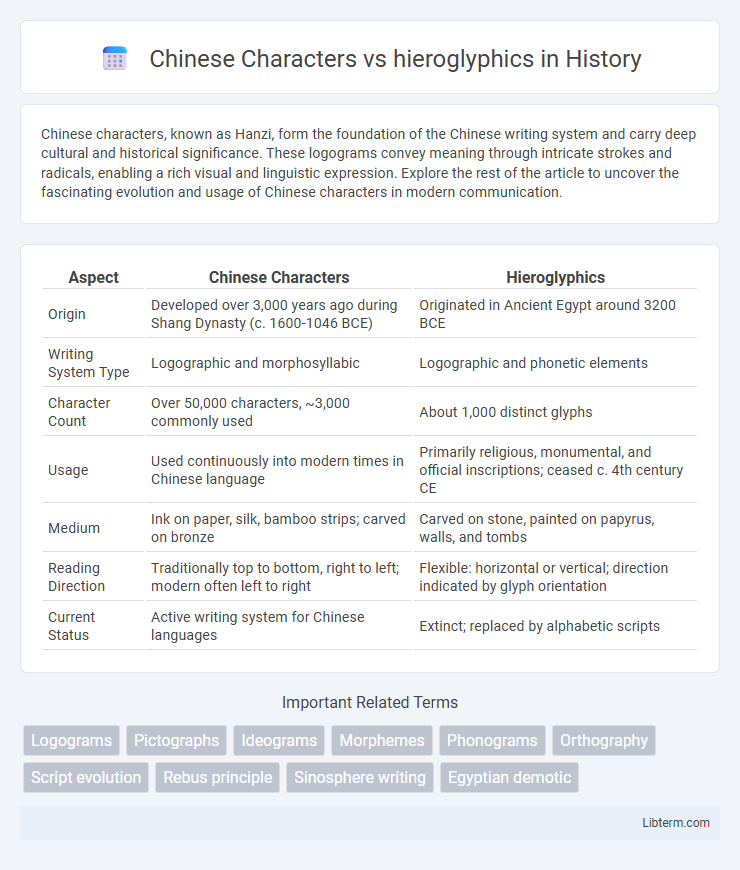Chinese characters, known as Hanzi, form the foundation of the Chinese writing system and carry deep cultural and historical significance. These logograms convey meaning through intricate strokes and radicals, enabling a rich visual and linguistic expression. Explore the rest of the article to uncover the fascinating evolution and usage of Chinese characters in modern communication.
Table of Comparison
| Aspect | Chinese Characters | Hieroglyphics |
|---|---|---|
| Origin | Developed over 3,000 years ago during Shang Dynasty (c. 1600-1046 BCE) | Originated in Ancient Egypt around 3200 BCE |
| Writing System Type | Logographic and morphosyllabic | Logographic and phonetic elements |
| Character Count | Over 50,000 characters, ~3,000 commonly used | About 1,000 distinct glyphs |
| Usage | Used continuously into modern times in Chinese language | Primarily religious, monumental, and official inscriptions; ceased c. 4th century CE |
| Medium | Ink on paper, silk, bamboo strips; carved on bronze | Carved on stone, painted on papyrus, walls, and tombs |
| Reading Direction | Traditionally top to bottom, right to left; modern often left to right | Flexible: horizontal or vertical; direction indicated by glyph orientation |
| Current Status | Active writing system for Chinese languages | Extinct; replaced by alphabetic scripts |
Introduction to Chinese Characters and Hieroglyphics
Chinese characters, known as Hanzi, are logograms used in the writing of Chinese and some other Asian languages, characterized by their complex strokes and rich history dating back over 3,000 years. Hieroglyphics, primarily associated with ancient Egypt, are symbolic pictographic scripts that combine logographic and alphabetic elements to convey religious and administrative information. Both writing systems represent early human attempts to encode language visually but differ significantly in structure, function, and cultural context.
Historical Origins and Development
Chinese characters originated over 3,000 years ago during the Shang Dynasty, evolving from early oracle bone inscriptions used for divination and record-keeping. Hieroglyphics, developed around 3,100 BCE in ancient Egypt, combined logographic and alphabetic elements to represent sounds and meanings in religious and monumental texts. Both writing systems reflect complex symbolic representations tied to their cultures' historical, religious, and administrative practices, yet Chinese characters evolved into a continuous, adaptable script still in use today.
Structure and Form: A Comparative Analysis
Chinese characters are logograms consisting of radicals and strokes arranged within an imaginary square, where each character represents a morpheme or word with phonetic and semantic components. Hieroglyphics, primarily used in ancient Egypt, combine logographic and alphabetic elements, featuring pictorial symbols that depict objects, sounds, or ideas, often arranged directionally along horizontal or vertical lines. Unlike the systematic stroke order in Chinese writing, hieroglyphics rely on spatial positioning and contextual symbols, reflecting distinct structural and functional principles.
Function and Usage in Ancient Civilizations
Chinese characters served as a logographic writing system primarily representing words and morphemes, enabling precise communication in administration, literature, and ritual contexts throughout ancient China. Hieroglyphics in ancient Egypt combined logographic and phonetic elements, functioning to record religious texts, monumental inscriptions, and governmental decrees with symbolic and phonetic meanings. Both systems were integral to their civilizations' cultural identity and bureaucratic organization, yet Chinese characters evolved into a continuous script for everyday use while hieroglyphics remained largely ceremonial and formal.
Phonetic vs. Ideographic Elements
Chinese characters combine both phonetic and ideographic elements, with phonetic components indicating pronunciation and ideographic components conveying meaning. Hieroglyphics primarily rely on pictorial symbols that represent objects, ideas, or sounds, often blending phonetic and semantic content. The balance of phonetic clues in Chinese characters enhances reading efficiency, while hieroglyphics emphasize symbolic representation within religious and cultural contexts.
Script Evolution: Continuity and Change
Chinese characters evolved from ancient pictographs and ideographs, maintaining a balance between symbolic representation and phonetic elements that allowed for continuity over millennia. Unlike hieroglyphics, which largely ceased as a living script after the decline of ancient Egypt, Chinese script has continuously adapted through standardized reforms such as the Qin dynasty's small seal script and the 20th-century simplification movements. This evolutionary flexibility helped sustain the script's functional and cultural relevance across vast historical and social changes.
Role in Cultural Identity and Tradition
Chinese characters serve as a vital link to China's rich historical and cultural heritage, embodying millennia of linguistic evolution and artistic expression. Unlike hieroglyphics, which were primarily used for religious and ceremonial purposes in ancient Egypt, Chinese characters continue to function in everyday communication, literature, and education, reinforcing national identity and cultural continuity. The preservation and teaching of Chinese characters play a crucial role in maintaining traditional values and fostering a collective sense of identity across generations.
Decipherment and Modern Understanding
Chinese characters, a logographic writing system dating back over 3,000 years, differ from hieroglyphics by representing morphemes rather than pictorial representations alone. Decipherment of ancient Chinese scripts, such as oracle bone inscriptions, relied heavily on continuity with modern characters, enabling scholars to trace linguistic evolution and semantic meanings. Modern understanding integrates phonetic components and radicals within characters, facilitating advanced computational analysis and enhancing language education worldwide.
Influence on Contemporary Writing Systems
Chinese characters have significantly influenced contemporary East Asian writing systems, notably Japanese kanji and Korean hanja, which incorporate these logographic symbols to convey meaning. Unlike purely phonetic alphabets, Chinese characters combine semantic and phonetic elements, enabling nuanced expression and cultural continuity across centuries. This unique structure has inspired the development of complex scripts that blend logographic and syllabic components in modern East Asian languages.
Conclusion: Lasting Impact on World Communication
Chinese characters, as one of the oldest continuously used writing systems, have profoundly influenced East Asian languages and culture, enabling complex expression and preservation of history. Hieroglyphics, while monumental in ancient Egyptian communication and art, eventually gave way to alphabetic scripts, limiting their direct influence on modern written systems. The enduring legacy of Chinese characters lies in their adaptability and integration into contemporary digital communication, highlighting their sustained global impact on language and literacy.
Chinese Characters Infographic

 libterm.com
libterm.com